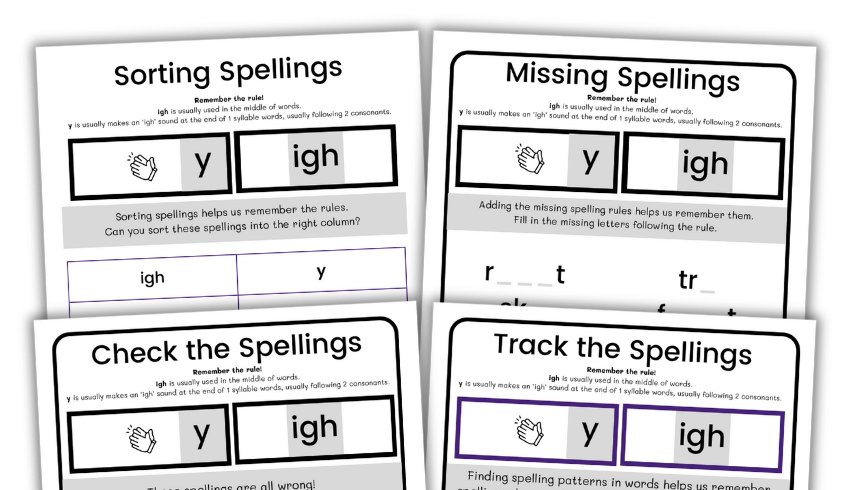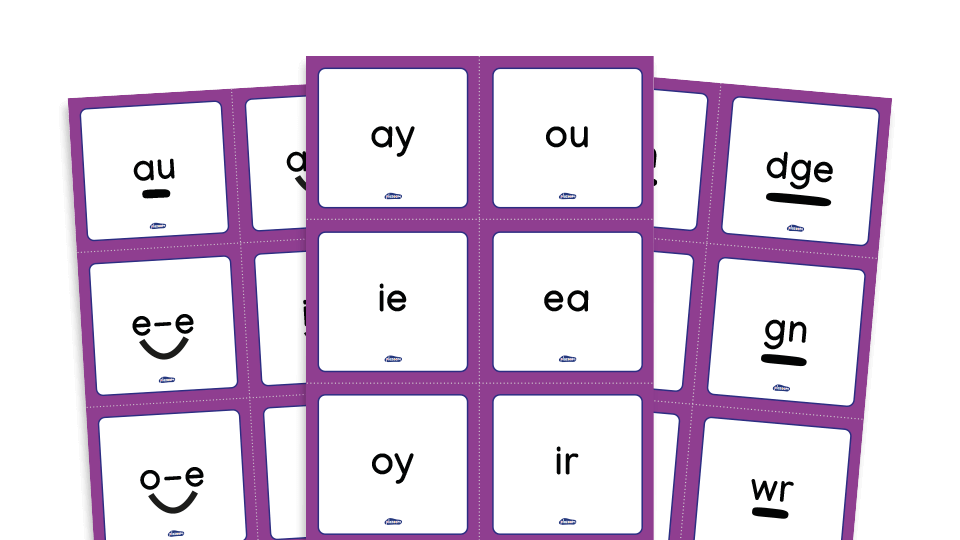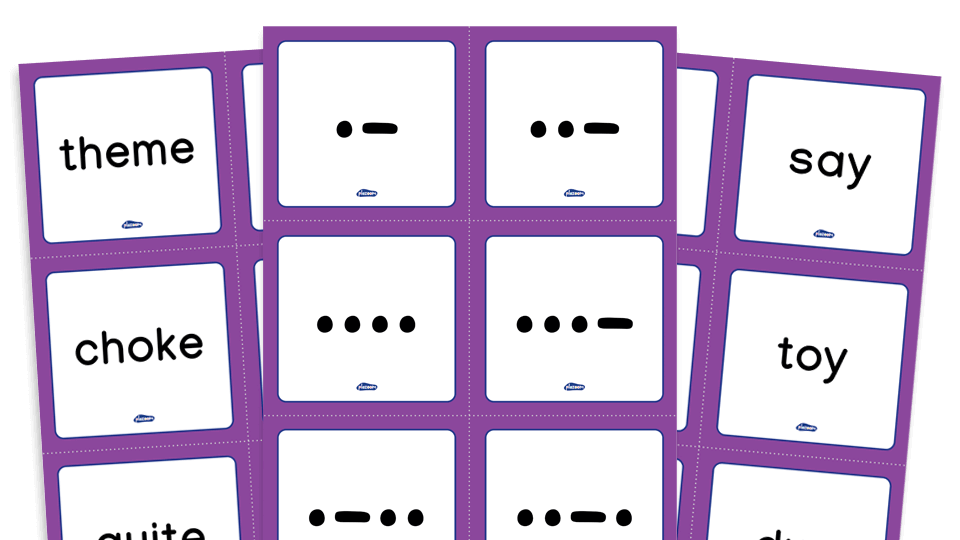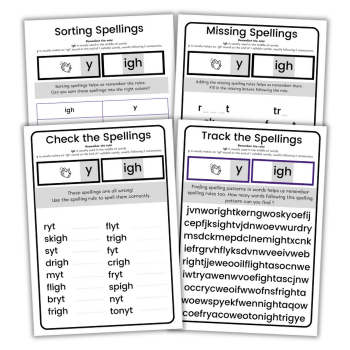PDF worksheets
KS1, KS2
Years 1-6
Phase 5 phonics is undoubtedly the most challenging element of phonics to teach and learn.
Building on Phase 2, Phase 3 and Phase 4, it tackles the complex part of the English alphabetic code step by step. Read on for expert advice about teaching this tricky area…
What is Phase 5 phonics?
Phase 5 phonics involves introducing children to the many alternative ways of representing spoken sounds using different spellings. They also learn that you can pronounce some spellings in several different ways.
Fundamental skills
- Secure the basic alphabetic code, including blending and segmenting, before beginning Phase 5 phonics
- Know the general rules for how to apply different spelling patterns or how alternative spellings affect sound pronunciation in words
- Ensure children understand the rules for applying a typical spelling pattern before introducing words that illustrate exceptions
- Follow a four-part teaching sequence to securely embed new learning or deploy a validated phonics programme with a good level of consistency
- Phase 5 phonics games should be interactive and engaging to build memory of the complex alphabetic code. There should also be plenty of opportunities to build on blending and segmenting skills too
Phase 5 phonics worksheets

Download these Phase 5 phonics worksheets from the top of this page for free. They cover the use of igh and y. Pupils must:
- Fill in the missing letters following the spelling rule
- Sort spellings into the right columns
- Use spelling rules to rewrite words correctly
- Find words that follow a particular spelling pattern
Sound cards

This sound cards resource from literacy resources website Plazoom is perfect for helping pupils revisit and respond speedily with the correct sound for different graphemes.
What age is Phase 5 phonics taught?
Although we commonly introduce Phase 5 phonics in Year 1, you should only begin once the learning from Phases 2–4 has been properly established and consolidated.
This is because the complex alphabetic code builds on the basic sounds and letter combinations introduced in the earlier phases.
How to teach Phase 5 phonics
You’ll generally teach Phase 5 phonics according to the systematic synthetic phonics programme your school follows.
Most schools in England follow the prescribed routines and strategies outlined by programmes validated by the Department of Education. This is a strongly recommended route, but is not mandatory.
Most phonics programmes follow a similar pattern of delivery, based on the most effective ways children learn. This usually follows a four-part teaching sequence introduced in Letters and Sounds:
- Review and revisit
- Teach
- Practise
- Apply
Revision and prior learning
Phase 5 phonics lessons generally begin by revising prior learning. This always relates to the new learning introduced in the lesson.
For example, revisit words containing the common ‘igh’ trigraph in a lesson which introduces the alternative ‘ie’ spelling for the same spoken sound.
This part of the teaching sequence brings stored learning into the working memory, ready for children to use it for reading and writing new words.
This provides little impact on learning beyond an initial reminder, so deliver it as rapidly as possible.
The revise and revisit part of a phonics lesson may include using flashcards or slides, where children recall and join in with a call and response to the visual prompt.
It may also involve finding or isolating a particular letter combination from a collection of letters or words.
- Secure the basic alphabetic code, including blending and segmenting, before beginning Phase 5 Phonics.
- Know the general rules for how different spelling patterns are applied or how alternative spellings affect sound pronunciation in words.
- Ensure children understand the rules for applying a typical spelling pattern before introducing words that illustrate exceptions.
- Follow a four-part teaching sequence to securely embed new learning or deploy a validated phonics programme with a good level of consistency.
- Phonics games should be interactive and engaging to build memory of the complex alphabetic code. There should also be plenty of opportunities to build on blending and segmenting skills too.
Teaching new Phase 5 phonics sounds
Always teach new Phase 5 phonics sounds by building on children’s knowledge of the basic alphabetic code. It’s essential they have a thorough understanding of when to apply different spelling rules.
For example:
- igh – commonly in the middle of words (bright)
- ie – frequently at the end of 1-syllable words (pie)
- i-e (the split digraph) – represented in the middle of words that end with the spoken sounds k, m, d, p, l (bike, time, ride, stripe, while)
- i – usually on its own when preceded or followed by two consonants (kind, wild)
- y – mostly at the end of 1 syllable words, preceded by 2 consonants (try)
Providing a child-friendly explanation at the point of teaching is critical to learning the complex alphabetic code. For this reason, carefully select the words you are going to use to exemplify the rule.
The English language is full of exceptions. It’s essential to introduce these only once you’ve established a rule. The complex code in Phase 5 phonics can be overwhelming, and it’s vital to teach each rule step-by-step.
As part of the teaching process, teach children to hear, say and form the new element of the alphabetic code alongside the new spelling rule. This helps with memory retention.
Practising Phase 5 phonics words
The Phase 5 words that children practise reading and spelling include the newly introduced part of the alphabetic code plus contrasting alternatives.
For example, in a lesson where children have been learning that ‘y’ at the end of a one-syllable word, preceded by two consonants, makes the ‘igh’ sound, words used for reading and spelling might include sky, try, fly, spy and dry.
Contrast these with other 1-syllable words ending in ‘ie’ at the end of words only preceded by one consonant. These words could include die, pie, lie, and tie.
This not only maximises the opportunity for children to read and spell many words, including new and prior learning, but also embeds spelling rules in context.
Applying Phase 5 phonics
Complete this part of a phonics teaching sequence at sentence level. It’s arguably the most crucial part of the teaching sequence, helping children move beyond single sounds and words to reading and writing full sentences.
For example, if ‘y’ and ‘ie’ were the focus of the practise part of the teaching sequence, a sentence to read or write should apply words that embed the rule taught and practised, e.g. I lie on the grass to look up at the sky.
This part of the teaching sequence requires significant adult modelling and is not an assessment opportunity.
“This part of the teaching sequence requires significant adult modelling”
Children need lots of repetition at this stage, so introduce sentences one word at a time. Reading and rereading sentences several times ensures that overlearning takes place. This improves reading and writing fluency over time.
“This part of the teaching sequence requires significant adult modelling”
The objective of the ‘apply’ part of the teaching sequence is to equip children to apply the new learning in broader reading and writing opportunities.
Phase 5 phonics games
The complex alphabetic code you introduce in this phase contains a lot of information for children to remember. Therefore, it’s vital to optimise engagement and practise memory-building skills during your daily delivery.
Use Phase 5 phonics games where children have to recall missing letters in words or missing words in sentences to help build rapid memory recall.

Pupils will revisit and apply their Phase 5 phonics knowledge from Letters and Sounds when playing this Dots and Dashes game from literacy resources website Plazoom.
Games including the misapplication or sorting of alternative spellings are also helpful. These reinforce spelling patterns by encouraging children to look more closely and improve reasoning around Phase 5 concepts.
Games where reading or spelling words is a ‘race against the clock’ are also ideal for building reading and spelling automaticity.
Emma Spiers is an author, early literacy consultant and trainer. Visit learninglady.co.uk

Similar resources
- Buddhism charity KS2 – Explore dāna (Buddist generosity concept)
- Solubility KS2 – Investigate solubility with common ingredients
- Fast fashion effects on environment – Fashion show art lesson
- Cobweb by Michael Morpurgo – Cross-curricular activities for KS2
- Refugee poem – Lesson plan for the poem ‘Unbroken’













